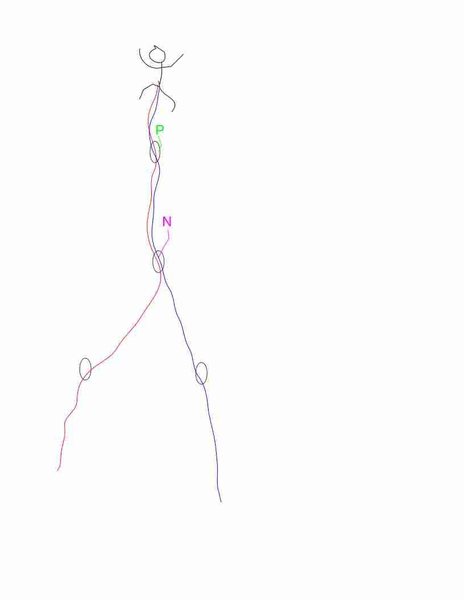Combining double and twin technique within a pitch
|
|
I've been thinking about a potential issue when double ropes are initially used as doubles and then recombined as twins within a pitch. (There was a discussion here on concerns about friction and heat as the ropes run at different speeds through a single carabiner; this is a different concern). |
|
|
I'll see you " the resultant vector forces" and raise you "the tension and tangent function". |
|
|
Do you worry about things a lot generally? |
|
|
I "combined" clipping like that on a couple occasions and each time got really tangled up and a worse rope drag than using a single line. I don't understand that technique. Maybe it is useful in some cases, or maybe it requires practice. For me it's either double or twin technique, not a combination of the two. |
|
|
kcradford wrote:Do not recombine doubles. Why would you ever clip the ropes the way you are showing themin the drawing? double ropes are desiged to have one rope through each pice of gear,and are not intended to be used as twins. you are increacing the forces on the pices that have both ropes cliped to them.Some ropes are rated for both double and twin use, though I imagine the fall will be jarring when both clipped (I hate falling anyway so not really a difference to me). I think the reasons to clip both would be a situation where an emphasis would be on the using twins in the first place. Somewhere you have a higher expectation of cutting a rope perhaps. It's an edge case for sure. The upward force will be pretty negligible unless that angle is very wide, but yes it could slide pieces upward. If you insist on going to twin and you're concerned place two pieces. The first in the direction of the fall, the second in the expected direction of pull due to rope separation. However, I think your better plan if you're in this situation debating is to pause and ask MP, but this time please include a photograph of your setup. MP currently sucks at hypotheticals but should be better at a current position, bear with them in the meantime. |
|
|
Haven't finished the morning coffee yet, so most of the verbiage is over my non-caffeinated head. |
|
|
kcradford wrote: Why would you ever clip the ropes the way you are showing themin the drawing?Reducing rope stretch = ledgefall potential is the main reason. I've done it, and I know lots of other climbers have as well. The conclusion of the previous thread was that it was generally safe (including email from a Mammut rep); but that thread was mainly concerned with friction and heating as ropes run at different speeds. |
|
|
Your diagram shows the two independent ropes clipped into carabiners roughly in the same horizontal plane. Also, they are shown fairly close vertically to the carabiner where they are both clipped together. Both of these maximize the angle that they enter that carabiner. |
|
|
The last pieces clipped separately don't have to be at the same height in this scenario, that was just a convenient way to draw it. They do need to be separated left and right of the recombined piece for these concerns, so that the tensioning ropes will pull outwards in opposite directions. |
|
|
kevin neville wrote:The last pieces clipped separately don't have to be at the same height in this scenario, that was just a convenient way to draw it. They do need to be separated left and right of the recombined piece for these concerns, so that the tensioning ropes will pull outwards in opposite directions.Then draw it again and I think you'll see you're worried about nothing. |
|
|
you mean use half rope technique as half rope technique, and use twin technique as twin technique? |
|
|
Draw it with the ledge and the last good stance from which she placed the last piece. It may make more sense. ... |
|
|
I think the general idea is: It depends on the situation. In rarely encountered circumstances the rope system you are describing has a use. In most, you shouldn't do that. |
|
|
On a climb with multiple ledges the last thing I would wanna do it to create more friction. As it is its already a huge pia. The rope drag will be so you will not be able to progress up the route because of it and will need to back clean. |
|
|
I don't mean so far out that a double length runner creates that much rope drag. Just enough that if you were to fall, you would swing away from the ledge. If that's not possible, and you think you might hit the ledge then chalk it up in the no fall category. |
|
|
FAIL! Zippy, I was saying combining twin and doubles rope technique is PIA. ...and so is your so called wit. DOUBLE FAIL! |
|
|
Zippy then don't interact with me, simple as that. Some people are just always on different pages. If you live long enough and pay attention you will see for yourself. So go amaze folks who get you. |
|
|
Zippy you are right for once. I don't like you. I don't like your style. I think you are dick. So do I care that you are a dick? No. Why do you feel so obligated to start threads about me, tell me how you hate my guts and what kind of anguish I'm causing you by being so annoying to you. Let it go. Take some pills smoke some weed and let it ghhoooo.. |

 Continue with onX Maps
Continue with onX Maps Continue with Facebook
Continue with Facebook





















